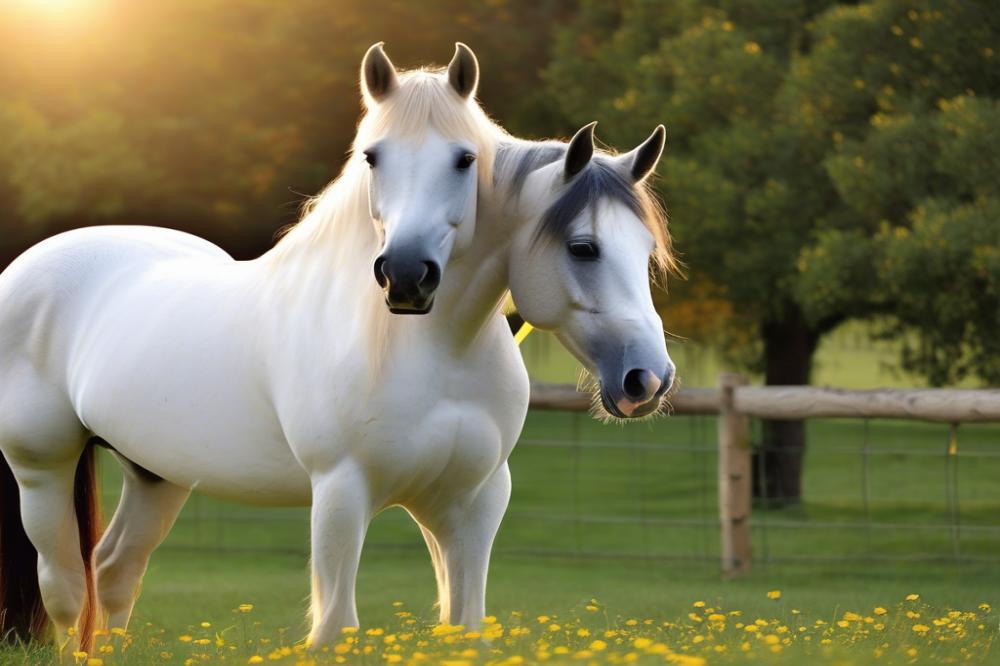Understanding Cryptorchidism in Horses
Have you ever heard of cryptorchidism in horses? It’s a fancy term that refers to a condition where one or both of a stallion’s testicles fail to descend into the scrotum. For horse owners and enthusiasts alike, this might seem like just another equine issue, but understanding it is crucial. Why? Well, a healthy horse is a happy horse. Knowing about this condition can play a key role in ensuring that their health and overall well-being are maintained.
The significance of being aware of cryptorchidism stretches beyond just diagnosis. Recognizing the signs early can lead to effective treatment, making it vital for horse care. Nobody wants to see their four-legged friend suffering when there’s so much joy (and a bit of mischief) in their life! Imagine a horse trying to keep up with the herd, feeling like something is not right. It’s like being the kid who forgot to bring their lunch to school—awkward and a bit worrisome.
In this article, we will explore a few key areas. First, we’ll dive into what exactly cryptorchidism is, how it affects horse health, and the various measures taken in cryptorchidism treatment. We’ll also touch on the long-term implications this condition might have on a horse’s life, including those robust horse exercises to build muscle. Finally, we will cover some tips for horse owners on maintaining good health and well-being for their equine companions. As we saddle up for this ride, you’ll find that understanding this topic can make a world of difference, and perhaps even call to mind why branding horses meaning goes beyond just marking livestock—it’s about understanding the whole picture of their care.
So grab your reins, and let’s trot into the world of cryptorchidism in horses!
Overview of Horse Anatomy

Basic Reproductive Anatomy of Male Horses
Male horses have some interesting anatomy. They possess two testicles, which are usually located in the scrotum. This pouch is situated outside the body. It helps keep the testicles at a cooler temperature than the internal body heat. Sperm cells require cooler temperatures for proper development. The penis is another crucial part of the male reproductive system. It typically needs to extend during mating.
Normal Testicular Descent Process
In young colts, testicles start their journey from the abdomen. This journey usually occurs during the first few months of life. They descend into the scrotum as the colt matures. Most of the time, this descent happens without any issues. The horse grows bigger, and as he does, the testicles find their rightful place. However, if one or both fail to descend, it leads to a condition often seen in equine health discussions.
Differences Between Cryptorchid and Normal Anatomy
In normal anatomy, testicles sit snugly in the scrotum. When we think about cryptorchid horses, things look quite different. One or sometimes both testicles are missing from the scrotum. They may still be located in the abdomen or inguinal canal. This can be a serious concern for horse care. Not only does it affect hormone production, but it also puts the horse at risk for health issues. Cryptorchidism treatment options are available, but outcomes may vary. Horse well-being is essential, so timely intervention is crucial.
Causes of Cryptorchidism

When it comes to understanding cryptorchidism in horses, several factors come into play. Humans often think about genes, like pieces in a puzzle. Genetic factors can dictate a horse’s physical traits, and sometimes those traits cause issues with reproductive organs. If a stallion’s family tree has a history of this problem, that might be a clue. Breeding decisions can sometimes magnify these genetic quirks, leading to more equine issues down the line.
Environmental influences also play a significant role in horse health. Horses live in various settings, from lush pastures to confined stables. Each environment can impact their development. For instance, exposure to certain chemicals or pollutants might disrupt a horse’s growth. If a horse is stressed or experiencing poor nutrition, that could lead to complications too. Mother Nature doesn’t always play fair, after all.
Conditions during fetal development make a big difference as well. Just like young humans, developing foals need the right conditions to thrive. If there are hormonal imbalances in the mother, that can influence the foal’s reproductive system. The timing of physical changes is crucial. If something goes wrong in those early stages, a horse might be born with cryptorchidism. This is why horse care experts often emphasize the health of pregnant mares in their guidelines. After all, a healthy mama horse tends to raise a healthy baby.
Furthermore, thinking about horse well-being means recognizing that these factors can interact in complex ways. It’s not always straightforward, but identifying these causes can help owners and veterinarians in managing equine health effectively. Better awareness leads to better decisions, whether it’s about breeding or caring for a colt with a specific issue. When it comes to cryptorchidism treatment, knowing the root causes allows for more targeted interventions. Education and understanding can go a long way in preventing this condition.
Types of Cryptorchidism in Horses

When discussing cryptorchidism in horses, it’s important to know the different types. There are mainly two categories: unilateral and bilateral. Unilateral cryptorchidism involves one testicle failing to descend. This situation can sometimes go unnoticed, making it trickier to spot. On the other hand, bilateral cryptorchidism means neither testicle has reached its proper position. This condition can have significant effects on the horse’s health and well-being.
Next, let’s talk about abdominal cryptorchidism. Here, the testicle remains tucked away in the abdomen. It’s like hiding a toy in a drawer that is never opened! Horses with this type may experience more severe complications if not treated. The internal location can lead to hormonal imbalances or even health risks over time. Horse care becomes essential in these situations to monitor any signs of discomfort.
Inguinal cryptorchidism is another type worth mentioning. This condition occurs when the testicle is stuck in the inguinal canal. It’s kind of like having one foot in a sock and the other foot out! These horses often appear normal, but problems can arise. If an inguinal testicle gets twisted, it could lead to serious equine issues. Regular checks and open communication with a veterinarian are crucial for maintaining horse health.
Each type has its unique challenges and treatment methods. Of course, the goal is always to optimize horse well-being. You can never underestimate the importance of prompt cryptorchidism treatment. The earlier you catch it, the less your horse has to deal with ongoing challenges.
Diagnosis of Cryptorchidism
Clinical Signs and Symptoms
Detecting cryptorchidism in horses can be tricky. Often, owners may notice that a stallion doesn’t act like one. Is the horse overly calm? Is he not showing the usual behaviors associated with stallions? A lack of aggression or not being interested in mares can be red flags. Sometimes, swelling around the abdomen is seen. These signs hint at a deeper problem. If something seems off, it’s time to investigate further.
Physical Examination Techniques
Veterinarians have specialized ways to examine horses. A thorough physical examination is crucial. The doctor looks for both testicles. If one is missing, that can be a sign of cryptorchidism. Feelings of abnormality during the exam may also suggest issues. The vet might even check for other potential equine health problems at the same time. Catching things early is key to keeping a horse healthy.
Diagnostic Imaging Methods
When the physical exam raises flags, imaging comes into play. Ultrasound is a go-to tool for many vets. It helps visualize internal organs and can locate a hidden testicle. X-rays might also be used, but they are less common for this condition. Seeing inside a horse helps to confirm what’s wrong or right. Diagnostic imaging can be a game changer for horse care and treatment plans.
Importance of Early Diagnosis
Waiting too long to diagnose cryptorchidism can cause more issues. Early detection helps in deciding the right cryptorchidism treatment. The earlier problems are found, the better for the horse’s health. It can prevent complications like hormone imbalance or tumors. Owners should always be on the lookout. Keeping tabs on their horse’s well-being is vital. After all, it’s no fun when your horse isn’t feeling its best.
Treatment Options
Surgical Intervention
Treating cryptorchidism in horses often means surgery. Vets focus on locating and removing the retained testicle. This procedure can be done through various methods, like laparoscopic surgery. Laparoscopy lets the veterinarian work with tiny incisions. Patients experience less pain and faster recovery with this approach.
Castration Techniques for Cryptorchid Horses
Castration is a common option for managing this equine issue. There are different techniques involved. Some vets prefer an open technique, which involves a larger incision. Others might use the closed method, which is less invasive. Each method has its own risks and benefits. Discussing the right technique with a veterinarian is key for horse health.
Post-operative Care and Recovery
After surgery, keeping an eye on the horse is vital. They might feel discomfort or anxiety. Providing a quiet, comfortable space can help. An ice pack on the surgical site may reduce swelling. Pain management medications usually are prescribed to keep your horse feeling fine.
Monitoring for any signs of infection is essential during recovery. A healthy appetite and normal behavior are good signs. Always follow up with the veterinarian to check that everything is healing well. Horse care doesn’t stop after the operation; ongoing attention and care are crucial for optimal recovery.
Implications of Cryptorchidism
Effect on Breeding Potential
When a stallion has cryptorchidism, it can be a real setback for breeding. Undescended testicles affect hormone levels, which play a big role in fertility. If a horse can’t produce normal sperm, that’s a roadblock for many owners looking to breed. Breeding programs demand reliable stallions, and missing testicles can mean a stallion doesn’t make the cut. It’s like bringing a fork to a soup party—it just doesn’t work!
Health Risks Associated with Undescended Testicles
Health problems run deeper with cryptorchidism. When testicles stay inside the body, they can become susceptible to various health issues. A horse might develop tumors, infections, or even torsion, which is like a bad twist in your favorite spaghetti! Let’s not forget that undescended testicles can lead to pain as well. Pain isn’t something anyone—be it horse or human—should ignore. Keeping an eye on equine health is essential for all horse owners.
Impact on Horse Performance and Behavior
Performance can take a hit, too. Horses with this condition might be less energetic, which isn’t what you want in a show or race. They might act differently as they struggle with hormonal imbalances. One minute they could be aloof, the next, overly aggressive. These behavior swings can confuse even the most seasoned riders. If you’re not sure what’s bothering your horse, it’s always good to check for potential equine issues.
Horse care means understanding these factors. Treating cryptorchidism isn’t just about fixing the crucial parts; it’s about ensuring overall horse well-being. Proper cryptorchidism treatment usually involves surgery, but being proactive about these health concerns can make all the difference. Your horse deserves the best, and a little attention goes a long way towards happy, healthy horses.
Preventative Measures and Management
Monitoring Breeding Stallions
Stallion owners should keep a close watch on their breeding horses. Regular veterinary check-ups help catch any potential issues with cryptorchidism early on. If a stallion isn’t behaving like a typical male, it may signal underlying problems. A quick assessment can save time and money later. Observing the horse’s physical traits is also key. If things seem a bit off, a vet should take a look. It’s all about keeping an eye on what’s normal for your horse.
Genetic Considerations in Breeding Programs
Breeders must pay attention to the genetics of their horses. Choosing stallions and mares with a history of good reproductive health is essential. If there’s a pattern of equine issues in the family, it’s wise to think twice before breeding from those animals. Cryptorchidism can have a hereditary component. Keeping records of the horse’s lineage can help spot potential problems before they arise. Knowledge is power when it comes to horse health!
Recommendations for Horse Owners
Horse owners play a crucial role in promoting overall well-being. Ensure your horses receive proper nutrition and exercise. Both can impact their reproductive health. Watch for signs that something isn’t right. Acting quickly can make a world of difference. If you suspect an issue, don’t hesitate to consult a veterinarian. Regular care goes a long way. Talk to fellow horse owners about their experiences and insights. Sharing stories or advice can really help others navigate the complexities of horse care.
Research and Future Directions
Recent studies on cryptorchidism
There is quite a bit happening in the world of equine health when it comes to cryptorchidism. Researchers are digging deeper into why some horses don’t seem to drop both testicles. They’ve looked at how certain factors, like age and breed, play a role in this issue. While most horses are healthy, having one or both testicles retained can lead to big problems later on. Therefore, understanding the root causes can help vets put together better plans for horse care.
Advances in treatment options
Treatment options have come a long way. In the past, surgery was the main way to correct this condition. Now, with advances in veterinary techniques, veterinarians can use less invasive methods. New surgical tools allow for quicker recovery times, which is a relief for both horses and their owners. With the right cryptorchidism treatment, equine issues caused by undescended testicles can often be resolved swiftly. Happy horses mean happy owners!
Potential for genetic testing in horses
Genetic testing is starting to attract attention in horse health. This method might shed light on why some horses develop cryptorchidism. Imagine being able to predict which foals could have this issue before they even hit the ground! Such advancements could transform horse breeding and care for future generations. Having this knowledge would also help breeders make better decisions, leading to improved horse well-being throughout the industry.
It’s an exciting time for equine research. The more we learn, the better we can take care of our four-legged friends!
Wrapping It Up
To sum things up, cryptorchidism in horses can be quite the puzzler for many horse owners and breeders. It involves a stallion whose testicles fail to descend properly. Ignoring this condition is not an option; it can lead to health issues and complications that can affect not only the horse’s well-being but also its performance and breeding capabilities. Those who own or raise horses should keep a keen eye on their animals when they are young, as early detection can make all the difference. After all, an ounce of prevention is worth a pound of cure!
Awareness is key. Many people may think, “Oh, my horse looks fine,” but some issues can hide just below the surface, waiting for the worst moment to reveal themselves. You wouldn’t want to discover your beloved horse has a serious problem during a competition, would you? The goal is to create a happy, healthy environment for our equine friends. So, let’s not just sit around like a donkey v mule pondering our next move. Instead, let’s be proactive!
Horse owners and breeders have an important role to play here. Regular check-ups with a veterinarian can keep you well-informed about your horse’s health. Your vet can help monitor for any signs of this condition and suggest the best course of action if needed. After all, your horse doesn’t have a horse GPS to help guide it through life. They rely on you to navigate their health and happiness.
In closing, take the time to educate yourself and share this knowledge with fellow horse lovers. Whether you’re in the stable or out riding, let’s keep talking about cryptorchidism in horses and other health concerns. Together, we can create a supportive community that puts our horses first. Let’s ride this journey together and ensure every horse gets the best care possible!



